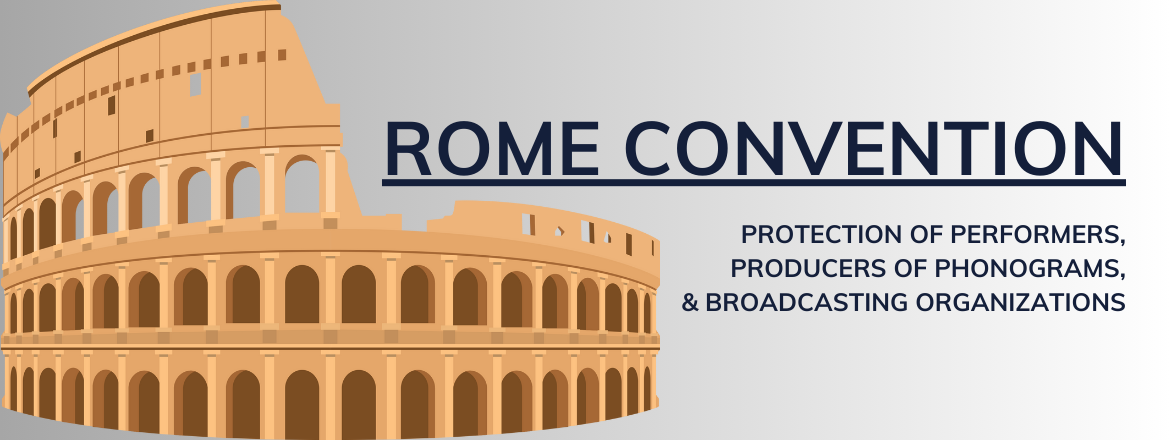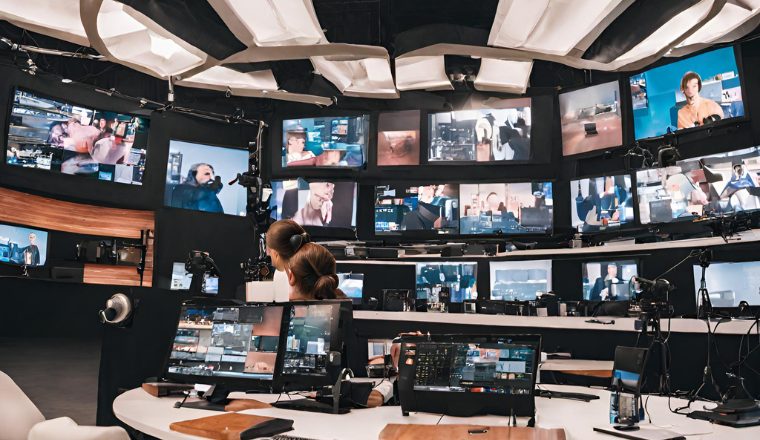Rome Convention for the Protection of Performers, Producers of Phonograms and Broadcasting Organizations

Introduction
The Rome Convention, established on October 26, 1961, stands as a pivotal treaty on the global stage, meant to navigate the ever-evolving environment of copyright regulations, particularly in the realms and domain of artistic performances, phonograms, and broadcasts.
This treaty stems from the imperative to adapt to technological advancements in visual and auditory media, with the overarching goal of reflecting the global commitment to safeguarding intellectual property rights in these respective sectors.
The Rome Convention has 96 contracting parties as of August 2021, highlighting its significance in the international legal environment. A comprehensive list of participating countries can be found here.
Administrative Oversight and International Cooperation
Governed by the World Intellectual Property Organization (WIPO) and in collaboration with the International Labour Organization (ILO) and the United Nations Educational, Scientific, and Cultural Organization (UNESCO), the Rome Convention further establishes an intergovernmental committee composed of contracting states to both deliberate upon and persistent issues related to its implementation.
This collaborative approach ensures that the pact maintains sustainable adaptability, in the face of today’s highly dynamic intellectual property rights landscape.
(Also read our article on the Beijing Treaty on Audiovisual Performances)
The Significance of the Rome Convention
The Rome Convention is primarily concerned with preserving a diverse range of artistically derived media, theatrical arts professions, and organizations. This encompasses performers, singers, musicians, dancers, and other types of performing artists; as well as those in charge of creating and modifying the audiovisual effects of said performances, such as sound engineers and broadcasting institutions.
The scope of artistic protection under the Rome Convention includes the regulation of prohibited acts such as broadcasting, fixation, and reproduction, as well as the appreciation and protection of individualistic contributions that are creative in nature.
The following sections highlight and elucidate key articles that explain how the treaty accomplishes these objectives.
The Significance of the Rome Convention
The Rome Convention is primarily concerned with preserving a diverse range of artistically derived media, theatrical arts professions, and organizations. This encompasses performers, singers, musicians, dancers, and other types of performing artists; as well as those in charge of creating and modifying the audiovisual effects of said performances, such as sound engineers and broadcasting institutions.
The scope of artistic protection under the Rome Convention includes the regulation of prohibited acts such as broadcasting, fixation, and reproduction, as well as the appreciation and protection of individualistic contributions that are creative in nature.
The following sections highlight and elucidate key articles that explain how the treaty accomplishes these objectives.
-
Defining Points of Attachment
The Convention is a cornerstone in the global protection of intellectual property rights, specifying attachment points for performers, phonogram manufacturers, and broadcasting companies. It both ensures and maintains consistent protection among the Contracting States by legally mandating national treatment of performers, linkages to performances from other states, inclusion in protected phonograms, and the guarantee of a secure delivery environment.
Furthermore, the Rome Convention clearly outlines guidelines for determining phonogram national treatment, taking key aspects like a producer’s nationality and fixation place into high consideration. And to address the challenge of concurrent publishing, Contracting States are permitted to exclude themselves, if they wish to do so.
Such provisions of the agreement broaden the attachment points for broadcasting organizations by integrating protection to either the headquarters or the transmission site. Thus, allowing them further flexibility through state declarations. These integrations strive to unify international protection, highlighting the convention's commitment to providing a similar method to securing and further promoting the longevity of artistically derived performances, phonograms, and broadcasts around the world.
-
Performers' Rights
The Rome Convention extends protection to creative performers, particularly those contributing to live artistic expressions. This protection extends to managing and blocking broadcasting, fixation, and reproduction of their performances.
The agreement fully recognizes the requirement for performers to obtain permission for acts related to their performances, in order to both showcase and uphold their creative liberty. This not only empowers performing artists but also creates the groundwork for fair compensation for the commercial use and distribution of their artistic endeavors and creative labor.
-
Phonogram Producers' Exclusive Rights
Individuals or entities looking to invest in the development of sound recordings such as phonogram producers, have been taken into account, within the agreement. The Rome Convention allows these producers to hold exclusive rights to authorize or prohibit the direct or indirect reproduction of their phonograms, including (but not limited to) music.
Contracting States may also impose formalities, such as requirements for notifications on copies of published phonograms identifying producers and performers.
The goal of this framework is to provide unified protection across international borders. It must be noted however, that when a phonogram is used directly for broadcasting or public communication, the user must remit a single equitable fee to the performers, producers, or both as per the terms governed by respective domestic regulations.


-
Broadcasting Organizations' Authority
Broadcasting organizations enjoy a number of unique privileges, including the ability to allow or prohibit rebroadcasting, fixation, copying, and general distribution of television broadcasts.
The adaptability of domestic law allows governments to modify the application of these rights to their legal frameworks.
-
Minimum Protection and Duration
The Rome Convention stipulates a minimum duration of protection of at least twenty years, commencing with the end of the year in which the fixing, performance, or distribution physically took place. Notably, national laws have been progressively shifting towards a 50-year term of protection, particularly for phonograms and performances.
This enhanced and extended protection reflects a recognition of the enduring value of creative works, despite its intangible nature, while also seeking to balance the interest of IP Rights holders.
-
Exceptions and Reservations
In addition to safeguarding intellectual property within the realms of artistic expression, the Rome Convention has incorporated flexible exceptions that allow all Contracting States to integrate exemptions into their domestic legislation(s). The treaty allows governments to offer exclusions for private use, current event reporting, teaching, or scientific study, as well as the power to apply local constraints akin to those applicable to copyright protection.
Furthermore, the treaty empowers contracting states to make declarations clarifying the scope and terms of applicability of certain treaty articles, allowing the convention's provisions to be tailored to further complement the legal landscape of an individual nation.
Conclusion
The Rome Convention is fully aligned with the preservation of a diverse medium of creatively produced media and theatrical arts professions and organizations, all the while regulating illegal acts such as broadcasting, fixation, and duplication.
Key articles in the treaty provide attachment points for performers, record corporations, and broadcasting firms, thereby unifying international protection. The rights of performers, the exclusive rights of phonogram manufacturers, and the authority of broadcasting organizations are meticulously detailed, emphasizing a harmonious balance between the interests of rights holders and the enduring value of creative works.
Abou Naja Intellectual Property strategically leverages the Rome Convention's opportunities, with creative producers and professionals continually enhancing their capacity to protect and administer intellectual property for the safeguarding of their artistic expressions.
As thought leaders, we advocate for robust protection methods in the ever-changing intellectual property landscape. Contact us today at [email protected] for comprehensive intellectual property solutions and a complimentary consultation. Your creative assets deserve the utmost protection, and we are here to ensure they thrive in the dynamic world of business and intellectual property.
Frequently Asked Questions
What is the Rome Convention, and when was it established?
The Rome Convention, established on October 26, 1961, is a global treaty addressing copyright regulations for artistic performances, phonograms, and broadcasts.
How many contracting parties does the Rome Convention have?
As of August 2021, the Rome Convention has 96 contracting parties, underscoring its international significance.
Which organizations oversee the Rome Convention's implementation?
The Rome Convention is governed by WIPO, with collaboration from ILO and UNESCO, maintaining adaptability in intellectual property rights.
Who benefits from the Rome Convention's protection?
The Rome Convention protects a diverse range of artists, performers, musicians, and broadcasting institutions, regulating acts like broadcasting, fixation, and reproduction.
What are the attachment points specified by the Rome Convention?
The Convention establishes attachment points for performers, phonogram manufacturers, and broadcasting companies, ensuring consistent protection among Contracting States.
What rights do performers have under the Rome Convention?
Performers receive protection for live artistic expressions, managing broadcasting, fixation, and reproduction rights, empowering them and ensuring fair compensation.
What exclusive rights do phonogram producers hold?
Phonogram producers have exclusive rights to authorize or prohibit reproduction, with protection across international borders as per the Rome Convention.
What authority do broadcasting organizations enjoy?
Broadcasting organizations can allow or prohibit rebroadcasting, fixation, copying, and distribution of television broadcasts, with adaptability to domestic law.
What is the minimum duration of protection under the Rome Convention?
The Rome Convention stipulates a minimum duration of at least twenty years, reflecting a balance between the interests of IP Rights holders and the enduring value of creative works.
Are there exceptions and reservations under the Rome Convention?
Yes, the Convention allows for flexible exceptions, including private use, current event reporting, teaching, or scientific study, with the ability for Contracting States to make declarations.






